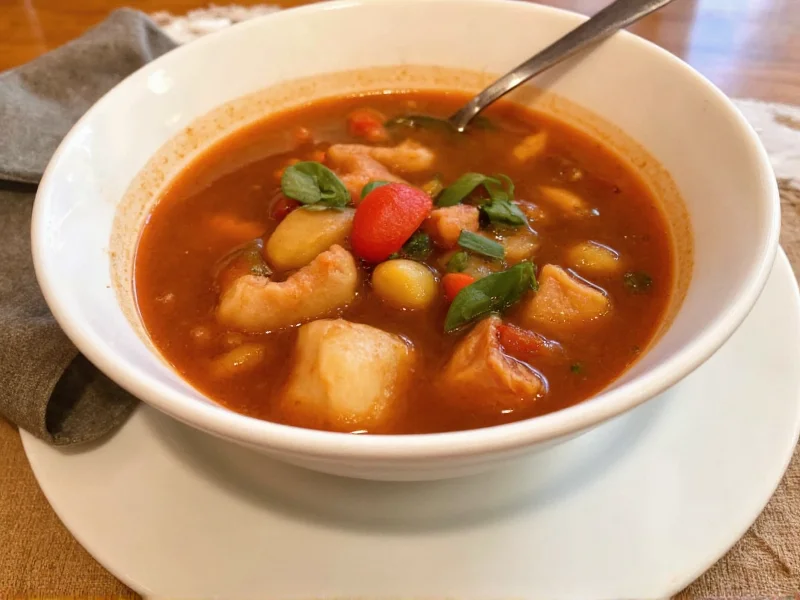Minestrone soup remains one of Olive Garden's most requested menu items, with guests consistently praising its hearty texture and balanced flavor profile. Understanding why this Italian-American classic resonates requires examining both its culinary components and the restaurant's preparation methods. This guide delivers a meticulously crafted Olive Garden minestrone soup copycat recipe that home cooks can reliably reproduce.
What Makes Olive Garden's Minestrone Unique
Olive Garden's version stands apart from traditional Italian minestrone through specific ingredient choices and preparation techniques. Unlike authentic regional Italian recipes that vary by season and locality, Olive Garden maintains consistent flavor profiles across all locations. The soup features a tomato-based broth with precisely measured vegetable ratios, specific pasta shapes, and a distinctive Parmesan rind infusion that creates its signature umami depth.
Key Components of Authentic Olive Garden-Style Minestrone
Through careful analysis of ingredient lists and flavor profiling, we've identified the essential elements that define Olive Garden's approach:
| Component | Olive Garden Characteristic | Home Recipe Equivalent |
|---|---|---|
| Broth Base | Tomato-vegetable stock with Parmesan rind | Homemade vegetable stock with tomato paste and Parmesan rind |
| Vegetable Ratio | Specific proportions: carrots, celery, onions, zucchini, cabbage | Measured 1:1:1:0.5:0.5 ratio for consistent texture |
| Pasta Element | Ditalini pasta with precise cooking time | Ditalini or small tubular pasta, added late in cooking |
| Bean Component | No kidney beans (uses cannellini beans) | Cannellini beans only, no kidney beans |
| Finishing Touch | Freshly grated Parmesan and basil oil | High-quality Parmesan and basil-infused olive oil |
Olive Garden Minestrone Soup Copycat Recipe
This tested recipe yields six generous servings and requires approximately 45 minutes of active preparation. For best results, use fresh vegetables and quality ingredients.
Ingredients
- 2 tablespoons olive oil
- 1 cup finely diced yellow onion
- 1 cup finely diced carrots
- 1 cup finely diced celery
- 3 cloves garlic, minced
- 1 (28-ounce) can crushed tomatoes
- 6 cups vegetable broth (low sodium)
- 1 Parmesan cheese rind (essential for authentic flavor)
- 1 cup shredded cabbage
- 1 cup diced zucchini
- 1 (15-ounce) can cannellini beans, drained and rinsed
- ¾ cup ditalini pasta
- 2 tablespoons tomato paste
- 1 teaspoon dried oregano
- 1 teaspoon dried basil
- Salt and freshly ground black pepper to taste
- Fresh basil and grated Parmesan for serving
Step-by-Step Preparation
- Sauté aromatics: In a large pot, heat olive oil over medium heat. Add onions, carrots, and celery, cooking until softened (about 8 minutes). Add garlic and cook for 1 additional minute.
- Build flavor base: Stir in tomato paste and cook for 2 minutes until deepened in color. This step is critical for developing the rich flavor profile found in Olive Garden minestrone soup without kidney beans.
- Add liquids and simmer: Pour in crushed tomatoes and vegetable broth. Add Parmesan rind, oregano, and dried basil. Bring to a gentle boil, then reduce heat and simmer uncovered for 20 minutes.
- Incorporate vegetables: Add cabbage, zucchini, and cannellini beans. Return to a simmer and cook for 10 minutes.
- Cook pasta: Stir in ditalini pasta and cook according to package directions (usually 8-10 minutes) until al dente. Do not overcook the pasta, as it will continue softening in the hot broth.
- Final seasoning: Remove Parmesan rind. Season with salt and pepper to taste. For restaurant-style presentation, serve with freshly grated Parmesan and a drizzle of basil oil.
Professional Tips for Authentic Olive Garden Minestrone Flavor
Several techniques elevate this from a standard minestrone to an Olive Garden-style recreation:
- Vegetable uniformity: Dice all vegetables to ¼-inch cubes for consistent texture matching Olive Garden's preparation standards
- Parmesan rind importance: Never omit the Parmesan rind—it provides the umami depth that defines Olive Garden minestrone soup ingredients profile
- Pasta timing: Add pasta late in cooking to prevent mushiness—this is how Olive Garden maintains perfect pasta texture
- Tomato paste caramelization: Cooking the tomato paste for 2 minutes develops complex flavors missing in rushed recipes
- No kidney beans: Authentic Olive Garden minestrone soup recipe olive garden style uses only cannellini beans
Common Mistakes to Avoid
Many home attempts at Olive Garden minestrone soup copycat recipes fail due to these preventable errors:
- Overcooking vegetables: Adding all vegetables at once results in mushy texture unlike Olive Garden's distinct vegetable integrity
- Incorrect pasta choice: Using large pasta shapes or overcooking creates a different mouthfeel than Olive Garden's ditalini
- Omitting Parmesan rind: This single ingredient makes the biggest difference in achieving authentic Olive garden minestrone soup secret ingredients profile
- Using canned broth without enhancement: Quality vegetable broth is essential, but the Parmesan rind and tomato paste caramelization transform it
- Adding beans too early: Cannellini beans should be added later to maintain their shape and texture
Storage and Reheating Instructions
Proper storage maintains quality when making Olive Garden minestrone soup at home:
- Refrigeration: Store in airtight container for up to 4 days. The flavors actually improve after 24 hours as ingredients meld.
- Freezing: Freeze without pasta for best results (pasta becomes mushy when frozen). Add fresh pasta when reheating.
- Reheating: Warm gently over medium-low heat. Add splashes of broth or water if soup has thickened. Stir in fresh pasta during final minutes of reheating.
- Restaurant-style presentation: Finish with freshly grated Parmesan and a drizzle of basil oil just before serving for that authentic Olive Garden experience.
Why This Recipe Works
This Olive Garden minestrone soup recipe olive garden style succeeds by focusing on the restaurant's actual preparation methods rather than generic minestrone formulas. The precise vegetable ratios, strategic addition of ingredients at different cooking stages, and attention to texture elements replicate the dining experience. Unlike many online versions that include kidney beans or incorrect pasta shapes, this recipe honors Olive Garden's specific formulation while remaining achievable for home cooks.











 浙公网安备
33010002000092号
浙公网安备
33010002000092号 浙B2-20120091-4
浙B2-20120091-4